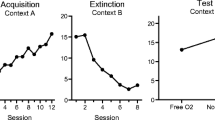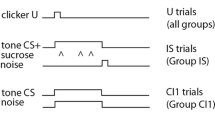Abstract
The present study investigated whether Pavlovian conditioning contributes, in the form of the response operandum serving as a conditioned stimulus, to the increase in the rate of response for 1% liquid-sucrose reinforcement when food-pellet reinforcement is upcoming. Rats were exposed to conditions in which sign tracking for 1% sucrose was measured when a subsequent period would or would not provide food pellets. Upcoming food pellets produced an increase in the sign-tracking response, but several accounts could potentially explain that increase. In a second experiment, rats responded at a higher rate for 1% sucrose on a lever predictive of upcoming food pellets than on a lever reliably followed by nonreinforcement. A similar result occurred in concurrent-choice probe sessions. These results, consistent with those of the first experiment, cannot be accounted for by the same alternative explanations and therefore suggest that Pavlovian conditioning can contribute to the observance of positive induction.
Similar content being viewed by others
References
HEARST, E., & JENKINS, H. M. (1974). Sign-tracking: The stimulus-reinforcer relation and directed action. Austin, TX: Psychonomic Society.
NATIONAL RESEARCH COUNCIL (1996). Guide for the care and use of laboratory animals. Washington, D.C.: National Academy Press.
RESCORLA, R.A. (2006). Stimulus generalization of excitation and inhibition. Quarterly Journal of Experimental Psychology, 59, 53–67.
REYNOLDS, G.S. (1961). Behavioral contrast. Journal of the Experimental Analysis of Behavior, 4, 57–71.
USLANER, J. M., ACERBO, M. J., JONES, S. A., & ROBINSON, T. E. (2006). The attribution of incentive salience to a stimulus that signals an intravenous injection of cocaine. Behavioural Brain Research, 169, 320–324.
WEATHERLY, J. N., ARTHUR, E. I. L., PALBICKI, J., & NURNBERGER, J. T. (2004). Induction produced by upcoming food-pellet reinforcement: Effects on subsequent operant responding. Learning and Motivation, 35, 189–207.
WEATHERLY, J. N., HIMLE, M. B., PLUMM, K. M., & MOULTON, P. L. (2001). Three tests of “anticipatory responding” as an account for induction produced by upcoming food-pellet reinforcement. Behavioural Processes, 56, 49–66.
WEATHERLY, J. N., KING, B. M., & URAN, E. L. (2003). Upcoming food-pellet reinforcement alters rats’ lever pressing for liquid sucrose delivered by a progressive-ratio schedule. Behavioural Processes, 63, 73–86.
WEATHERLY, J. N., LANG. K. K., & KING, B. M. (2004). Does the temporal placement of food-pellet reinforcement alter induction when rats respond on a three-component multiple schedule? Psychological Record, 54, 319–332.
WEATHERLY, J. N., LANG, K. K., KING, B. M., BESTE, R., & GROVE, C. (2006). Induction when rats lick for 1% liquid-sucrose reinforcement. Quarterly Journal of Experimental Psychology, 59, 654–666.
WEATHERLY, J. N., NURNBERGER, J. T., & KRISTIANSEN-MOEN, L. A. (2006). The role of place of reinforcer delivery in the appearance of positive induction when rats respond for 1% Sucrose. Behavioural Processes, 73, 156–163.
WEATHERLY, J. N., PLUMM, K. M., SMITH, J. R., & ROBERTS, W. A. (2002). On the determinants of induction in responding for sucrose when food pellet reinforcement is upcoming. Animal Learning & Behavior, 30, 315–329.
WEATHERLY, J. N., STOUT, J. E., MCMURRY, A. S., RUE, H. C., & MELVILLE, C. L. (1999). Within-session responding when different reinforcers are delivered in each half of the session. Behavioural Processes, 46, 227–243.
WEATHERLY, J. N., TISCHART, L. M., & PALBICKI, J. (2003). Stimulus control over induction produced by upcoming food-pellet reinforcement. Behavioural Processes, 64, 113–120.
WILLIAMS, B. A. (2002). Behavioral contrast redux. Animal Learning & Behavior, 30, 1–20.
Author information
Authors and Affiliations
Corresponding author
Rights and permissions
About this article
Cite this article
Weatherly, J.N., Huls, A. & Kulland, A. Pursuing the Pavlovian Contributions to Induction in Rats Responding for 1% Sucrose Reinforcement. Psychol Rec 57, 577–592 (2007). https://doi.org/10.1007/BF03395596
Published:
Issue Date:
DOI: https://doi.org/10.1007/BF03395596




